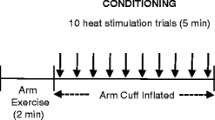Abstract
Fifty-two paid volunteers participated in two separate factorial investigations of the effects of naloxone on time tolerance of and affective reactions to ischemia, as a function of the interaction between expectations of involvement in the experimental situation and experimental variables involving stress or suggestions of analgesia. Naloxoneinduced reduction in tolerance to ischemia interacted significantly with the level of involvement expectancies. The suggestion of analgesia provided no significant naloxonesaline discriminations, but there was a significant interaction between variable memory task conditions and drug effects on the time ischemia was tolerated. These findings suggest that naloxone-opiate receptor interactions may depend on individual differences in attitudes to the situation, but may be potentiated by select environmental stimuli. Analyses of the effects of treatment on affective reactions to ischemia failed to show consistent results.
Similar content being viewed by others
References
Akil H, Madden J, Patrick RL, Barchas JD (1976) Stress-induced increase in endogenous opiate peptides: Concurrent analgesia and its reversal by naloxone. In: Kosterlitz HW (ed) Opiates and endogenous opioid peptides. North Holland, Amsterdam, pp 63–71
Amir S, Amit Z (1978) Endogeneous opioid ligands may mediate stressinduced changes in the affective properties of pain-related behaviour in rats. Life Sci 23:1143–1152
Barber TX, Calverley SS (1966) Effects of recall of hypnotic induction, motivation suggestions, and suggested regression: A methodological and experimental analysis. Abnormal Child Psychol 71:169–180
Chesher GB, Chan B (1977) Foot-shock-induced analgesia in mice: Its reversal by naloxone and cross-tolerance with morphine. Life Sci 21:1569–1574
Frederickson RCA (1977) Enkephalin pentapeptides: A review of current evidence for a physiological role in vertebrate neurotransmission. Life Sci 21:23–42
Frid M, Singer G (1979) Hypnotic analgesia in conditions of stress is partially reversed by naloxone. Psychopharmacology 63:211–215
Frid M, Singer G, Rana C (1979) Interactions between personal expectations and naloxone: Effects on tolerance to ischemic pain. Psychopharmacology 65:225–231
Goldstein A (1976) Oploid peptides (endorphins) in pituitary and brain. Science 193:1081–1086
Guillemin R, Vargo T, Rossier J, Minick S, Ling N, Rivier C, Vale W, Bloom F (1977) β-Endorphin and adrenocorticotropin are secreted concomitantly by the pituitary gland. Science 197:1367–1369
Jessel TM (1977) Opiate inhibition of substance P release from the rat trigeminal nucleus in vitro. J Physiol (Lond) 270:50–57
Knoll J, Illes P, Medzihradszky K (1978) The action of enkephalins and enkephalin analogues on neurotransmission in the isolated nictitating membrane of the cat. J Pharm Pharmacol 30:394–396
Kordon C, Enfalbert A, Carbonell J (1977) Central neurotransmitters and control of prolactin secretion. Ann Biol Anim Biochem Biophys 17:425–439
Levine JD, Gordon NC, Jones RT, Fields HL (1978a) The narcotic antagonist naloxone enhances clinical pain. Nature 272:826–827
Levine JD, Gordon NC, Fields HL (1978b) The mechanism of placebo analgesia. Lancet II:654–657
Liebeskind JC, Paul LA (1977) Psychological and physiological mechanisms of pain. Annu Rev Psychol 28:41–60
Mayer DJ, Price DP (1976) Central nervous system mechanisms of analgesia. Pain 2:379–404
Mihic D, Binkert E (1978) Is placebo analgesia mediated by endorphin? In: Pain abstracts: Second world congress on pain (Montreal), vol 1. International Association for the Study of Pain, Washington, p 19
Paimer MR, Morris DH, Taylor DA, Stewart JM, Hoffer BJ (1978) Electrophysiological effects of enkephalin analogs in rat cortex. Life Sci 23:851–860
Peck C, Nayman J (1980) The submaximum effort tourniquet test as a predictor of post-operative clinical pain. In: Peck C, Wallace M (eds) Problems in pain: Proceedings of the first Australia-New Zealand conference on pain. Sydney, Pergamon, pp 212–216
Smith GM, Egbert LD, Markowitz RA, Mosteller F, Becher HK (1966) An experimental pain method sensitive to morphine in man: The submaximum effort tourniquet technique. J Pharmacol Exp Ther 154:324–332
Snyder, SH (1977) Opiate receptors and internal opiates. Sci Am 236:44–56
Terenius L (1978) Endogenous peptides and analgesia. Annu Rev Pharmacol Toxicol 18:189–204
Yasukama N, Monder H, Michael SD, Christian JJ (1978) Opiate antagonist counteracts reproductive inhibition by porcine ACTH extract. Life Sci 22:1381–1390
Author information
Authors and Affiliations
Rights and permissions
About this article
Cite this article
Frid, M., Singer, G., Oei, T. et al. Reactions to ischemic pain: Interactions between individual, situational and naloxone effects. Psychopharmacology 73, 116–119 (1981). https://doi.org/10.1007/BF00429200
Received:
Accepted:
Issue Date:
DOI: https://doi.org/10.1007/BF00429200




